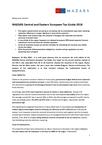
MAZARS CENTRAL AND EASTERN EUROPEAN TAX GUIDE 2018
MAZARS CENTRAL AND EASTERN EUROPEAN TAX GUIDE 2018
It is with great pleasure that we announce the sixth edition of the MAZARS Central and Eastern European Tax Guide. Our report on the current taxation regimes of the CEE is now expanded from 19 to 22 countries: beyond the countries of the region, Russia, Ukraine and the Baltic states, this year’s issue also includes Bulgaria, Kosovo and Germany. The purpose of this publication is to help investors compare the fundamental factors of competitiveness.
Highlights of 2018:
- The region’s governments are giving an increasing role to consumption-type taxes: boosting collection efficiency is a major objective in most of the countries
- Total labour cost remains high; the situation in Hungary has improved, but families continue to benefit most
- In two-thirds of the region taxpayers are allowed to prepare IFRS-based separate financial statements and to use these for taxation purposes
- Levels of corporate income tax and the methods for calculating the tax base vary widely across the region
- With the growth of documentation obligations, transfer pricing regulations are also becoming more stringent
We hope and trust that our readers will find this summary useful and inspiring. We also included the contact information for Mazars offices and experts.
Download the guide and a brief press release by clicking the link below.
Please visit the website of the Mazars CEE Tax Guide 2018:
Want to know more?



